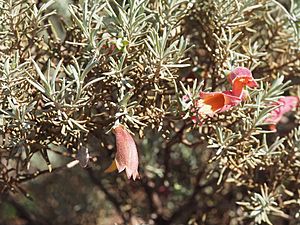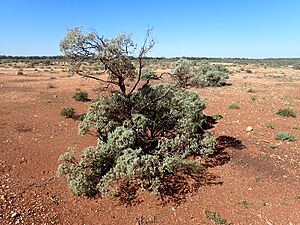Eremophila pterocarpa subsp. acicularis facts for kids
Quick facts for kids Eremophila pterocarpa subsp. acicularis |
|
|---|---|
 |
|
| Eremophila pterocarpa subsp. acicularis leaves and flowers | |
| Scientific classification |
|
| Kingdom: | Plantae |
| Clade: | Tracheophytes |
| Clade: | Angiosperms |
| Clade: | Eudicots |
| Clade: | Asterids |
| Order: | Lamiales |
| Family: | Scrophulariaceae |
| Genus: | Eremophila |
| Species: | |
| Subspecies: |
E. p. subsp. acicularis
|
| Trinomial name | |
| Eremophila pterocarpa subsp. acicularis Robert Chinnock
|
|
Eremophila pterocarpa subsp. acicularis is a special plant found only in Western Australia. It's a type of shrub that belongs to the figwort family, also known as Scrophulariaceae. This plant often has grey leaves and pretty red flowers that are orange inside. It's quite common in the areas where it grows.
Contents
What Does This Plant Look Like?
Eremophila pterocarpa subspecies acicularis is a shrub that can grow from about 0.6 to 1.8 meters (2 to 6 feet) tall. Its branches have small bumps, especially near their ends.
The leaves are thin and shaped like needles, about 10 to 18 millimeters (0.4 to 0.7 inches) long and 1 to 2 millimeters (0.04 to 0.08 inches) wide. Both the leaves and stems are covered in soft, powdery hairs. Unlike a similar plant, Eremophila pterocarpa subspecies pterocarpa, the leaves of this plant do not have twisted bases.
Flowers and Fruits
The flowers are a brick-red color on the outside and bright orange inside. They don't have any spots. Each flower grows by itself where a leaf meets the stem, on a stalk about 10 to 16 millimeters (0.4 to 0.6 inches) long.
The flowers have 5 sepals, which are like small, leaf-like parts that protect the flower bud. These sepals are narrow and triangular, and they are all about the same size. The petals, which are the colorful parts of the flower, are 14 to 24 millimeters (0.6 to 0.9 inches) long. They are joined together to form a tube with 5 small flaps at the end. Like the leaves, the sepals and petals also have a fine, dusty layer of hairs.
This plant usually flowers between June and July. After the flowers, it produces fruits that are flat, dry, and have papery wings.

How Was This Plant Named?
The main species, Eremophila pterocarpa, was first officially described in 1904 by a scientist named William Vincent Fitzgerald. He wrote about it in a scientific journal.
Later, another scientist named Robert Chinnock studied the Eremophila group of plants very carefully. He realized that this specific plant was a distinct type within the species, so he named it as a subspecies: E. pterocarpa subsp. acicularis.
Where Does This Plant Grow?
You can find Eremophila pterocarpa subspecies acicularis growing in areas between Wiluna and Meekatharra in Western Australia. It prefers places that are more rocky or salty compared to where the other subspecies, E. pterocarpa subspecies pterocarpa, grows.
Is This Plant Endangered?
The Government of Western Australia's Department of Parks and Wildlife has listed Eremophila pterocarpa subspecies acicularis as "not threatened." This means that there are enough of these plants in the wild, and they are not currently at risk of disappearing.

